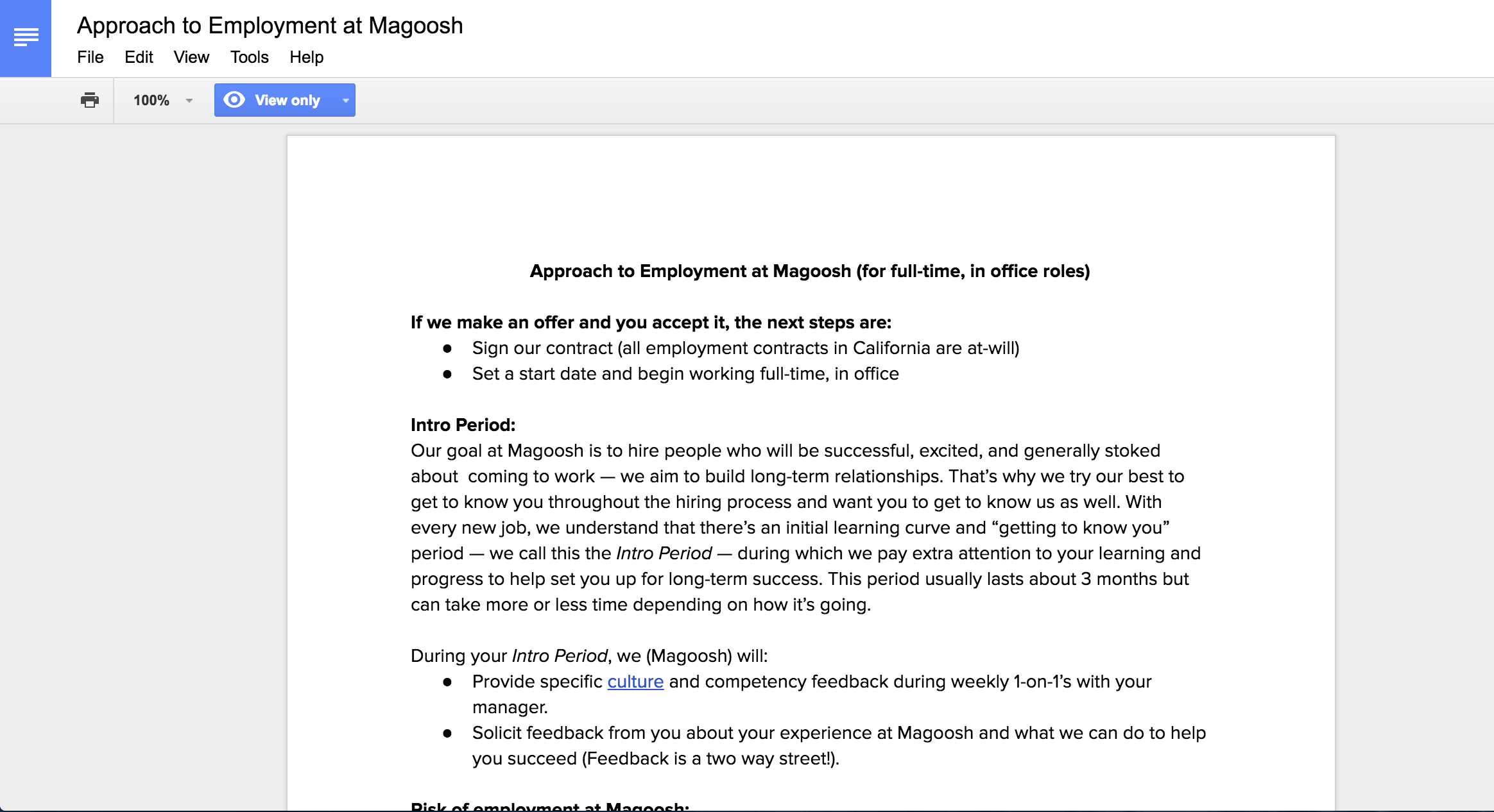This post was updated on September 6, 2016 based on changes we’ve made to our approach.
Many founders and VCs espouse the mantra hire fast, fire fast. There’s a sense of urgency to fill every open position, because every day a position is open is a day that work isn’t getting done. And if you make a hiring mistake, well, you can always fire that employee and try again with someone else. Sounds like good business, right?
But there’s a problem: employees are people, not resources. They are people with lives, obligations, and financial needs. Yes, you should focus on doing what’s best for your company, but you should also treat people with the respect they deserve.
An all-too-common anecdote (based on a real story)
SaasCo, a Bay Area startup, just raised a $7M round of funding and is hiring fast. They found Aaron, who lives in Cleveland, OH, and who had been searching for software engineering jobs in the Bay Area. SaasCo interviewed Aaron giving him a coding test and technical design question. They even flew him out so he could meet the team over lunch. All went well. Aaron got the job and relocated with his wife and kids (relocation expenses paid). The change was disruptive and expensive (due to the high cost of living) for his family , but he had a high-paying job at well-funded startup, and he and his family would adjust.
Six weeks into the role, the founder calls Aaron into his office and fires him. Aaron wasn’t delivering results. He was used to a slower pace with more structure, but SaasCo was a bit chaotic. Employees needed to make progress without being guided; the company needed to hit their metrics to raise their next round of funding. Aaron was struggling with the ambiguity and others were getting frustrated. The company paid Aaron a week of severance, and the founder knew he made the right business decision to let Aaron go.
Was the company right in letting Aaron go? Probably. Could they have handled the situation better? Definitely. These types of occurrences happen all too often. This “churn and burn” culture is not something I (or Magoosh) want to be part of. So how do we approach it?
Hire slow
Slow doesn’t mean what you might think it means. When hiring, you should move candidates through the process as quickly as possible. And when you find someone who’s a good fit, you should move quickly and make an offer.
Hiring slow means that you should be thorough. Don’t make the hiring decision based on a snap judgement. Create a structured process that tests for job and culture fit and fights against your biases. Google’s Senior Vice President of People Operations has written quite a bit on the topic.
A thorough process is fairer to potential employees. You’re doing the hard work of assessing fit up front, so that hopefully you won’t need to let them go. We’ve iterated on our process many times, and we’ll continue to do so. You can read more about our hiring process in detail here.
Fire fast, but humanely
Occasionally, you’ll need to let people go to protect your company and your other employees. After all, one person who’s not a fit can negatively affect everyone else. However, you can let people go and treat them with respect. Here’s how:
1. Share your stance on firing with employees BEFORE they join.
When new employees join companies, they often assume they have some level of job protection, maybe for a year—it’s an implicit understanding especially for those who have not worked in a fast-paced startup culture. But if you believe in firing fast, then you should explicitly let the new hire know about your approach. Even better, let them know what percent of people have been let go in the first 3 months. Let them opt into the risk of joining your company. Don’t rely on the employee’s understanding of at-will employment. Don’t lie by omission to get them to join.
2. Communicate expectations clearly and regularly
After you hire someone, spend time crafting a 3-month plan with them. Share what you expect them to accomplish and how you will measure their performance. If you don’t know all the specifics, then share your general expectations about performance and values. Have weekly one-on-ones (and daily check-ins in the first week or two) to share feedback and to give them time to ask questions. Your job is to help the new employee be successful, so early feedback is critical.
At Magoosh, we’re now better at this then we used to be, but we still have a lot of room for improvement. (I’m sure many Magooshers reading this didn’t have a clearly laid out 3-month plan when they joined—sorry!) We now try to do the following:
- Provide specific culture and competency feedback during weekly 1-on-1’s.
- Regularly (every 2 weeks or so) communicate how well the new employees are doing in their role.
- Solicit feedback from new employees about their experience at Magoosh and what we can do to help them succeed.
3. Offer a reasonable and well-defined severance.
For any number of reasons, things may not work out. But remember, when you fire someone, it’s your fault. If you had a better hiring process, you could have identified that this person wasn’t well-suited for the role or the company. Now the employee has to find another job, which takes time. We took inspiration from Rand Fishkin of Moz and offer one month of severance (assuming there were no egregious behavior issues). Think of severance as a “hiring penalty”: you pay it because you didn’t invest enough time in the hiring process, and it’s your incentive to make the hiring process better.
Here’s a link to a Google Doc we share with candidates during the hiring process which outlines how we approach the first few months, the Intro Period:

In the fast-paced startup culture — where every day matters — it’s easy for founders to hire and fire quickly. However, step back and evaluate the consequences of those actions. The people you hire are not disposable resources. Sometimes a relationship between an employee and a company doesn’t work out, and that’s ok. Let them go, but do so humanely and then improve your hiring process for the next hire.
Read more by Bhavin:
Why We Don’t Negotiate Salary and Neither Should You
How Being Named the Happiest Company Made Me Less Happy

Leave a Reply